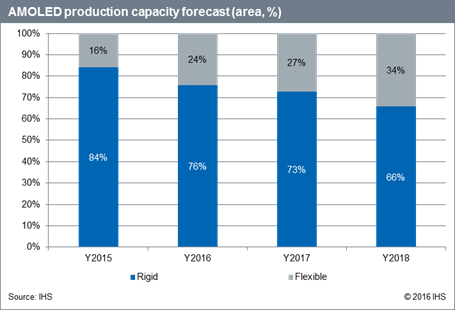|
Seeing the Future in Flexible AMOLED Displays, Manufacturers Expand Production Capacity in 2016, IHS Says
2/17/2016 |
|
|
ENGLEWOOD, Colo. (February 17, 2016) - With the growing popularity of the Samsung Galaxy Edge series and the Apple Watch, display manufacturers are expanding their production capacity of flexible active-matrix organic light-emitting diode (AMOLED) displays. While comprising just 2 percent of all AMOLED panel shipments in 2014, the share of flexible AMOLED panels rose to 20 percent of the total AMOLED display market in 2015, reaching 57 million units, according to IHS Inc. (NYSE: IHS), the leading global source of critical informational and insight.
The unit-shipment share of flexible AMOLED is expected to grow to 40 percent of total AMOLED panel shipments in 2020. Rigid AMOLED panel shipments, by comparison grew 30 percent to reach 233 million units in 2015. Production capacity for flexible AMOLED panels is expected to exceed 1.5 million square meters (24 percent of total AMOLED display production capacity area) in 2016,
"As the demand for flexible AMOLED rises dramatically, display manufacturers are aggressively investing in flexible AMOLED, including the latest foldable and rollable displays," said Jerry Kang, principal analyst of display research for IHS Technology. "In fact, the growth rate for flexible AMOLED panels is expected to be much higher than for rigid AMOLED panels beginning in 2016."
According to the IHS OLED Technology, Strategy & Market Report, Samsung Display lowered its manufacturing cost for rigid AMOLED panels, to compete with low temperature polysilicon (LTPS) liquid crystal displays (LCDs). Samsung Display's primacy in the rigid AMOLED market is now leading other panel makers to skip production of rigid AMOLED displays entirely and proceed directly to flexible AMOLED production.
"Manufacturers feel it's already too late to compete in the rigid AMOLED market, where Samsung Display is already so far ahead," said Kang. "Furthermore, a growing number of smartphone manufacturers, including Apple, are looking to thinner and lighter flexible AMOLED displays to differentiate their products, which is leading even more panel makers to rapidly shift their business focus to flexible AMOLED."
|
|
|
|
|
|

